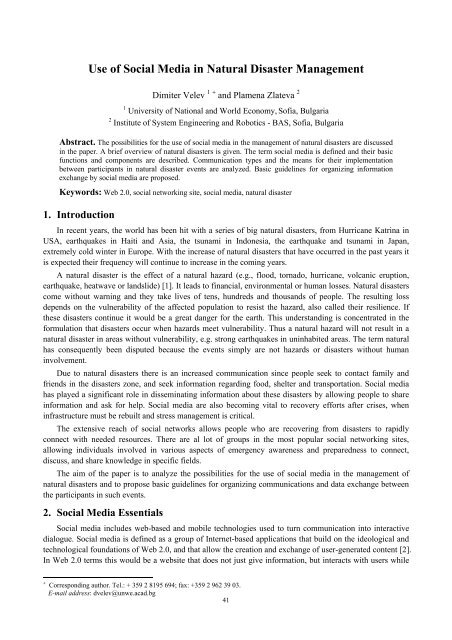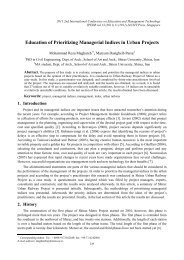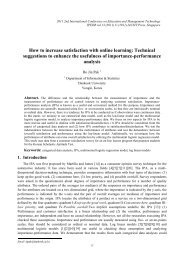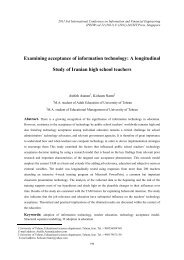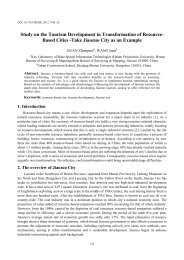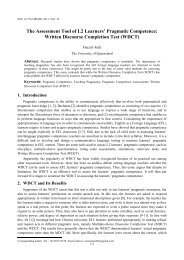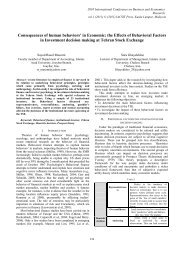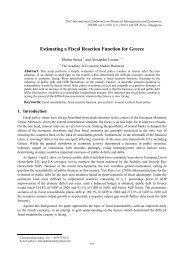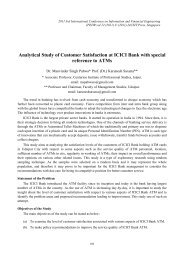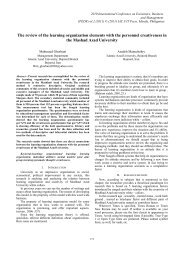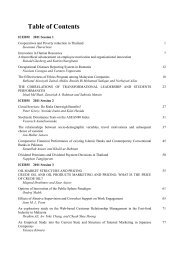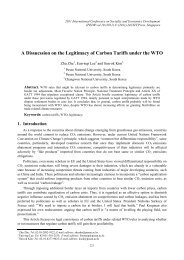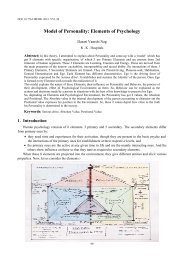Use of Social Media in Natural Disaster Management - ipedr
Use of Social Media in Natural Disaster Management - ipedr
Use of Social Media in Natural Disaster Management - ipedr
You also want an ePaper? Increase the reach of your titles
YUMPU automatically turns print PDFs into web optimized ePapers that Google loves.
<strong>Use</strong> <strong>of</strong> <strong>Social</strong> <strong>Media</strong> <strong>in</strong> <strong>Natural</strong> <strong>Disaster</strong> <strong>Management</strong><br />
Dimiter Velev 1 + and Plamena Zlateva 2<br />
1 University <strong>of</strong> National and World Economy, S<strong>of</strong>ia, Bulgaria<br />
2 Institute <strong>of</strong> System Eng<strong>in</strong>eer<strong>in</strong>g and Robotics - BAS, S<strong>of</strong>ia, Bulgaria<br />
Abstract. The possibilities for the use <strong>of</strong> social media <strong>in</strong> the management <strong>of</strong> natural disasters are discussed<br />
<strong>in</strong> the paper. A brief overview <strong>of</strong> natural disasters is given. The term social media is def<strong>in</strong>ed and their basic<br />
functions and components are described. Communication types and the means for their implementation<br />
between participants <strong>in</strong> natural disaster events are analyzed. Basic guidel<strong>in</strong>es for organiz<strong>in</strong>g <strong>in</strong>formation<br />
exchange by social media are proposed.<br />
Keywords: Web 2.0, social network<strong>in</strong>g site, social media, natural disaster<br />
1. Introduction<br />
In recent years, the world has been hit with a series <strong>of</strong> big natural disasters, from Hurricane Katr<strong>in</strong>a <strong>in</strong><br />
USA, earthquakes <strong>in</strong> Haiti and Asia, the tsunami <strong>in</strong> Indonesia, the earthquake and tsunami <strong>in</strong> Japan,<br />
extremely cold w<strong>in</strong>ter <strong>in</strong> Europe. With the <strong>in</strong>crease <strong>of</strong> natural disasters that have occurred <strong>in</strong> the past years it<br />
is expected their frequency will cont<strong>in</strong>ue to <strong>in</strong>crease <strong>in</strong> the com<strong>in</strong>g years.<br />
A natural disaster is the effect <strong>of</strong> a natural hazard (e.g., flood, tornado, hurricane, volcanic eruption,<br />
earthquake, heatwave or landslide) [1]. It leads to f<strong>in</strong>ancial, environmental or human losses. <strong>Natural</strong> disasters<br />
come without warn<strong>in</strong>g and they take lives <strong>of</strong> tens, hundreds and thousands <strong>of</strong> people. The result<strong>in</strong>g loss<br />
depends on the vulnerability <strong>of</strong> the affected population to resist the hazard, also called their resilience. If<br />
these disasters cont<strong>in</strong>ue it would be a great danger for the earth. This understand<strong>in</strong>g is concentrated <strong>in</strong> the<br />
formulation that disasters occur when hazards meet vulnerability. Thus a natural hazard will not result <strong>in</strong> a<br />
natural disaster <strong>in</strong> areas without vulnerability, e.g. strong earthquakes <strong>in</strong> un<strong>in</strong>habited areas. The term natural<br />
has consequently been disputed because the events simply are not hazards or disasters without human<br />
<strong>in</strong>volvement.<br />
Due to natural disasters there is an <strong>in</strong>creased communication s<strong>in</strong>ce people seek to contact family and<br />
friends <strong>in</strong> the disasters zone, and seek <strong>in</strong>formation regard<strong>in</strong>g food, shelter and transportation. <strong>Social</strong> media<br />
has played a significant role <strong>in</strong> dissem<strong>in</strong>at<strong>in</strong>g <strong>in</strong>formation about these disasters by allow<strong>in</strong>g people to share<br />
<strong>in</strong>formation and ask for help. <strong>Social</strong> media are also becom<strong>in</strong>g vital to recovery efforts after crises, when<br />
<strong>in</strong>frastructure must be rebuilt and stress management is critical.<br />
The extensive reach <strong>of</strong> social networks allows people who are recover<strong>in</strong>g from disasters to rapidly<br />
connect with needed resources. There are al lot <strong>of</strong> groups <strong>in</strong> the most popular social network<strong>in</strong>g sites,<br />
allow<strong>in</strong>g <strong>in</strong>dividuals <strong>in</strong>volved <strong>in</strong> various aspects <strong>of</strong> emergency awareness and preparedness to connect,<br />
discuss, and share knowledge <strong>in</strong> specific fields.<br />
The aim <strong>of</strong> the paper is to analyze the possibilities for the use <strong>of</strong> social media <strong>in</strong> the management <strong>of</strong><br />
natural disasters and to propose basic guidel<strong>in</strong>es for organiz<strong>in</strong>g communications and data exchange between<br />
the participants <strong>in</strong> such events.<br />
2. <strong>Social</strong> <strong>Media</strong> Essentials<br />
<strong>Social</strong> media <strong>in</strong>cludes web-based and mobile technologies used to turn communication <strong>in</strong>to <strong>in</strong>teractive<br />
dialogue. <strong>Social</strong> media is def<strong>in</strong>ed as a group <strong>of</strong> Internet-based applications that build on the ideological and<br />
technological foundations <strong>of</strong> Web 2.0, and that allow the creation and exchange <strong>of</strong> user-generated content [2].<br />
In Web 2.0 terms this would be a website that does not just give <strong>in</strong>formation, but <strong>in</strong>teracts with users while<br />
+ Correspond<strong>in</strong>g author. Tel.: + 359 2 8195 694; fax: +359 2 962 39 03.<br />
E-mail address: dvelev@unwe.acad.bg<br />
41
giv<strong>in</strong>g them <strong>in</strong>formation. <strong>Social</strong> media is media for social <strong>in</strong>teraction as a super-set beyond social<br />
communication. Enabled by ubiquitously accessible and scalable communication techniques, social media<br />
has substantially changed the way organizations, communities, and <strong>in</strong>dividuals communicate.<br />
<strong>Social</strong> <strong>Media</strong> are the platforms that enable the <strong>in</strong>teractive web by engag<strong>in</strong>g users to participate <strong>in</strong>,<br />
comment on and create content as means <strong>of</strong> communicat<strong>in</strong>g with other users and the public. <strong>Social</strong> media has<br />
the follow<strong>in</strong>g characteristics [3]:<br />
• Encompasses wide variety <strong>of</strong> content formats <strong>in</strong>clud<strong>in</strong>g text, video, photographs, audio, PDF and<br />
PowerPo<strong>in</strong>t. Many social media make use <strong>of</strong> these options by allow<strong>in</strong>g more than one content<br />
alternative.<br />
• Allows <strong>in</strong>teractions to cross one or more platforms through social shar<strong>in</strong>g, email and feeds.<br />
• Involves different levels <strong>of</strong> engagement by participants who can create or comment or on social<br />
media networks.<br />
• Facilitates enhanced speed and breadth <strong>of</strong> <strong>in</strong>formation dissem<strong>in</strong>ation.<br />
• Provides for one-to-one, one-to-many and many-to-many communications.<br />
• Enables communication to take place <strong>in</strong> real time or asynchronously over time.<br />
• Is device <strong>in</strong>different? It can take place via a computer, tablets and smartphones.<br />
• Extends engagement by creat<strong>in</strong>g real-time onl<strong>in</strong>e events, extend<strong>in</strong>g onl<strong>in</strong>e <strong>in</strong>teractions <strong>of</strong>fl<strong>in</strong>e, or<br />
augment<strong>in</strong>g live events onl<strong>in</strong>e.<br />
<strong>Social</strong> media operates through social media websites implement<strong>in</strong>g functions such as [4]:<br />
• <strong>Social</strong> Bookmark<strong>in</strong>g (Del.icio.us, Bl<strong>in</strong>klist, Simpy) - Interact by tagg<strong>in</strong>g websites and search<strong>in</strong>g<br />
through websites bookmarked by other people.<br />
• <strong>Social</strong> News (Digg, Propeller, Reddit) - Interact by vot<strong>in</strong>g for articles and comment<strong>in</strong>g on them.<br />
• <strong>Social</strong> Network<strong>in</strong>g (Facebook, Hi5) - Interact by add<strong>in</strong>g friends, comment<strong>in</strong>g on pr<strong>of</strong>iles, jo<strong>in</strong><strong>in</strong>g<br />
groups and hav<strong>in</strong>g discussions.<br />
• <strong>Social</strong> Photo and Video Shar<strong>in</strong>g (YouTube, Flickr) - Interact by shar<strong>in</strong>g photos or videos and<br />
comment<strong>in</strong>g on user submissions.<br />
• Wikis (Wikipedia) - Interact by add<strong>in</strong>g articles and edit<strong>in</strong>g exist<strong>in</strong>g articles.<br />
Such websites are not the only social media websites. Any website that <strong>in</strong>vites users to <strong>in</strong>teract with the<br />
site and with other visitors falls <strong>in</strong>to the def<strong>in</strong>ition <strong>of</strong> social media.<br />
3. <strong>Social</strong> <strong>Media</strong> <strong>in</strong> <strong>Natural</strong> <strong>Disaster</strong>s<br />
Onl<strong>in</strong>e social network<strong>in</strong>g services and social media like Facebook, Twitter, Google+, Etc. can act and try<br />
to solve many problems dur<strong>in</strong>g natural disasters [5]. Dur<strong>in</strong>g disasters all the conventional communications<br />
generally stop function<strong>in</strong>g at this time <strong>in</strong>terval while social media or network<strong>in</strong>g services stay active. Onl<strong>in</strong>e<br />
social networks allow the establishment <strong>of</strong> global relationships that are doma<strong>in</strong> related or can be based on<br />
some need shared by the participants. They have <strong>in</strong>vestigated whether or not the social network paradigm<br />
can be used to enable <strong>in</strong>dividuals and organizations to collaborate <strong>in</strong> mutually beneficial ways, <strong>in</strong> all stages<br />
<strong>of</strong> emergency management: mitigation, preparedness, response and recovery.<br />
Conducted research has found that though the use <strong>of</strong> mobile phones and email did predictably <strong>in</strong>crease <strong>in</strong><br />
the immediate aftermath <strong>of</strong> the earthquake the use <strong>of</strong> social network<strong>in</strong>g sites also <strong>in</strong>creased and even<br />
surpassed the use <strong>of</strong> more conventional methods <strong>of</strong> communication such as fixed phones [6]. Apart from the<br />
use <strong>of</strong> major public social network<strong>in</strong>g services, many companies actively used their own secured corporate<br />
social network<strong>in</strong>g services after disasters to confirm the safety <strong>of</strong> employees<br />
As with any new technology, there rema<strong>in</strong> many hurdles between current use and optimal exploitation <strong>of</strong><br />
social media [7]. Although these media are used by people <strong>of</strong> both sexes and an expand<strong>in</strong>g range <strong>of</strong> ages, it<br />
is important to recognize and explore the technology's limitations <strong>in</strong> reach<strong>in</strong>g at-risk, vulnerable populations.<br />
It is not always possible to know whether social media users are who they claim to be or whether the<br />
<strong>in</strong>formation they share is accurate. Although false messages that are broadcast widely are <strong>of</strong>ten rapidly<br />
corrected by other users, it is <strong>of</strong>ten difficult to separate real signals <strong>of</strong> a health crisis or a material need from<br />
42
ackground noise and opportunistic scams. Careful consideration must also be given to issues <strong>of</strong> privacy and<br />
the question <strong>of</strong> who should monitor data from social media [8].<br />
Most <strong>of</strong> the commentary about social media dur<strong>in</strong>g natural disasters has centered on its role as a news<br />
source. Certa<strong>in</strong>ly this is <strong>in</strong>valuable with <strong>in</strong>stantaneous <strong>in</strong>formation available across multiple devices, critical<br />
with power outages shutt<strong>in</strong>g down TV stations and landl<strong>in</strong>es. People need advice and <strong>in</strong>formation, not only<br />
<strong>in</strong> the wake <strong>of</strong> a disaster but also for ensur<strong>in</strong>g <strong>in</strong> advance that they are prepared. <strong>Disaster</strong>s br<strong>in</strong>g risk <strong>in</strong>to the<br />
ma<strong>in</strong>stream conversation as people have heightened concerns about their loved ones, and not just the ones <strong>in</strong><br />
the path <strong>of</strong> a disaster. Dur<strong>in</strong>g these periods, there are sharp <strong>in</strong>creases <strong>in</strong> the <strong>in</strong>formation shared about claims,<br />
preparedness tips and how-to <strong>in</strong>sure for the future. <strong>Social</strong> media is a critical shar<strong>in</strong>g vehicle because it<br />
already connects people and it is very easy [9].<br />
Emergency service agencies are utilis<strong>in</strong>g the power <strong>of</strong> social media and SMS to <strong>in</strong>stantly broadcast and<br />
amplify emergency warn<strong>in</strong>gs to the public [10]. The multi-channel communication approach <strong>in</strong>corporates<br />
ma<strong>in</strong>stream media. They monitor and actively crowdsource localised <strong>in</strong>formation from community agencies<br />
and the public, which they relay with geospatial <strong>in</strong>formation to emergency personnel on the scene. The<br />
public are directly receiv<strong>in</strong>g and act<strong>in</strong>g on localised, real-time emergency warn<strong>in</strong>g <strong>in</strong>formation via SMS<br />
alerts and messages to their social networks as well as the traditional channels <strong>of</strong> radio, TV and onl<strong>in</strong>e. They<br />
are directly access<strong>in</strong>g l<strong>in</strong>ks to onl<strong>in</strong>e <strong>in</strong>formation via a number <strong>of</strong> platforms <strong>in</strong>clud<strong>in</strong>g websites, mobile<br />
friendly sites, smartphone apps and video shar<strong>in</strong>g sites as well as social network<strong>in</strong>g sites. They are actively<br />
forward<strong>in</strong>g emergency agency messages to their social networks and amplify<strong>in</strong>g the warn<strong>in</strong>gs.<br />
The role <strong>of</strong> social media <strong>in</strong> the wake <strong>of</strong> natural disasters is still unclear, but sites like Facebook, Twitter<br />
and YouTube can be <strong>of</strong> great value when tsunamis, earthquakes, floods and other natural disasters<br />
strike.<strong>Social</strong> media [11]-<br />
• Provides valuable <strong>in</strong>formation to those <strong>in</strong> a disaster area pre and post disaster (via Internet, if<br />
available, or SMS updates).<br />
• Drives awareness to those outside the affected areas, generat<strong>in</strong>g volunteers and/or donors.<br />
• Connects displaced family & friends.<br />
• Provides <strong>in</strong>formation about unclaimed property, and <strong>in</strong> worst case scenarios, bodies.<br />
• Offers <strong>in</strong>formation about aid, centers and other resources available to those affected.<br />
A study by the American Red Cross shows more people are turn<strong>in</strong>g to sites like Facebook and Twitter to<br />
learn about emergencies, get <strong>in</strong>formation and check on friends and family [12]. Facebook, Youtube,<br />
MySpace and Twitter were the most popular social network sites when nature strikes.<br />
Research and reviews <strong>of</strong> different casea has identified the four primary ways that citizens use social<br />
media technologies dur<strong>in</strong>g natural disasters [13]:<br />
• Family and Friends Communication - To connect with family members between affected and<br />
unaffected communities/areas (or with<strong>in</strong> affected communities) for situation updates and plann<strong>in</strong>g<br />
responses. This is the most popular use. Primary tools used are Twitter, Facebook and/or a blog.<br />
• Situation Updates - Neighbours and communities share critical <strong>in</strong>formation between each other such<br />
as; road closures, power outages, fires, accidents and other related damages.<br />
• Situational/Supplemental Awareness - <strong>in</strong> a number <strong>of</strong> cases citizens rely less and less on authority<br />
communication, especially through traditional channels (television, radio, phone.)<br />
• Services Access Assistance - Citizens would use social media channels to provide each other with<br />
ways and means to contact different services they may need after a crisis.<br />
Before a disaster social media can help people better prepare for a disaster and understand which<br />
organizations will help their communities [14]. Dur<strong>in</strong>g the disaster social media helps users communicate<br />
directly to their families, reporters, volunteer organizations and other residents and immediately share<br />
<strong>in</strong>formation. It also controls rumors because it’s easier for organizations to validate facts. After the disaster,<br />
social media helps br<strong>in</strong>g the community together to discuss the event and share <strong>in</strong>formation, coord<strong>in</strong>ate<br />
recovery efforts and get <strong>in</strong>formation about aid.<br />
The use <strong>of</strong> social media for disaster preparedness has two components [15]:<br />
43
• As an effective means for provid<strong>in</strong>g updated <strong>in</strong>formation about a crisis, proactive steps must be taken<br />
prior to disasters <strong>in</strong> order for effective communications to occur.<br />
• As a part <strong>of</strong> crisis observation, managers should be monitor<strong>in</strong>g social media platforms and channels<br />
that may be relevant to their organization. Observ<strong>in</strong>g can be as simple as conduct<strong>in</strong>g regular searches<br />
and analyses <strong>of</strong> media platforms for keywords and phrases that may imply an emerg<strong>in</strong>g crisis or<br />
disaster. Monitor<strong>in</strong>g <strong>of</strong> social media should extend <strong>in</strong>to the crisis response and post-crisis phases to<br />
check how crisis management efforts are be<strong>in</strong>g received.<br />
Many researchers propose three ways to use social media dur<strong>in</strong>g natural disasters [16, 17, 18]:<br />
• Prepar<strong>in</strong>g for a natural disaster - though no one can predict an earthquake days <strong>in</strong> advance, social<br />
networks such, email and text messag<strong>in</strong>g could help people prepare for the emergency.<br />
• Respond<strong>in</strong>g dur<strong>in</strong>g and immediately after the natural disaster - this is especially the case for SMS<br />
messages and other communications that can be received through cellphones.<br />
• Recover<strong>in</strong>g from the natural - communication is done through social media.<br />
Nevertheless, the tendency to sensationalize news that is <strong>in</strong>herent <strong>in</strong> human nature, basic <strong>in</strong>formation<br />
may get disproportionately misconstrued as a result <strong>of</strong> which rumors are created, mislead<strong>in</strong>g people with<br />
regard to ongo<strong>in</strong>g activities. In the process, there is a loss <strong>of</strong> confidential <strong>in</strong>formation and victims may fail to<br />
be notified about revised safety measures. Eventually the lack <strong>of</strong> constant flow <strong>of</strong> communication can result<br />
<strong>in</strong> chaos and confusion.<br />
Critical tasks that can be implemented by social media [18]:<br />
• Prepare citizens <strong>in</strong> areas likely to be affected by a disaster;<br />
• Broadcast real-time <strong>in</strong>formation both for affected areas and <strong>in</strong>terested people;<br />
• Receive real-time data from affected areas;<br />
• Mobilize and coord<strong>in</strong>at<strong>in</strong>g immediate relief efforts; and<br />
• Optimize recovery activities.<br />
Concerns such as the threat <strong>of</strong> technology failure, hackers, stalkers, viruses, flam<strong>in</strong>g, and usability issues<br />
will have to be addressed <strong>in</strong> the development <strong>of</strong> emergency onl<strong>in</strong>e networks [5]. Current social networks<br />
have limitations <strong>in</strong> terms <strong>of</strong> the collaborative tools available to users that might be repurposed for emergency<br />
use, especially given as they were generally designed with socializ<strong>in</strong>g rather than emergency efforts <strong>in</strong> m<strong>in</strong>d.<br />
Nevertheless, with<strong>in</strong> a short time, even the most enhanced system will seem primitive as user requirements<br />
mature and develop <strong>in</strong> all areas. Systems will ultimately emerge that allow true collaboration and have<br />
complete user control. When develop<strong>in</strong>g the use <strong>of</strong> onl<strong>in</strong>e social networks, it is essential to engage<br />
emergency management personnel and their organizations <strong>in</strong> dialog to determ<strong>in</strong>e their concerns, needs and<br />
how to serve them <strong>in</strong> the best feasible manner.<br />
4. Conclusions<br />
<strong>Social</strong> media has re-def<strong>in</strong>ed communication <strong>in</strong> today’s modern world. Text messag<strong>in</strong>g, the <strong>in</strong>ternet and<br />
social network<strong>in</strong>g sites have made it possible to communicate with a large number <strong>of</strong> people anywhere on<br />
earth. It is an efficient and easy way to keep <strong>in</strong> touch and impart <strong>in</strong>formation, particularly <strong>in</strong> a time <strong>of</strong> crisis.<br />
The Internet has become an essential communication network dur<strong>in</strong>g this time. With thousands displaced<br />
from their homes and many hav<strong>in</strong>g fled the disaster zone, people turned to social network<strong>in</strong>g sites to contact<br />
friends, post photos and share stories. <strong>Social</strong> <strong>Media</strong> has become a valuable means <strong>of</strong> communication <strong>in</strong> many<br />
places affected by a natural disaster, which allows people to keep <strong>in</strong> touch with family and friends and access<br />
important <strong>in</strong>formation. <strong>Social</strong> media cannot and should not supersede current approaches to disastermanagement<br />
communication or replace exist<strong>in</strong>g <strong>in</strong>frastructure, but if managed strategically, they can be used<br />
to bolster current systems. Now is the time to beg<strong>in</strong> deploy<strong>in</strong>g these <strong>in</strong>novative technologies while<br />
develop<strong>in</strong>g mean<strong>in</strong>gful metrics <strong>of</strong> their effectiveness and <strong>of</strong> the accuracy and usefulness <strong>of</strong> the <strong>in</strong>formation<br />
they provide. <strong>Social</strong> media might well enhance systems <strong>of</strong> communication, thereby substantially <strong>in</strong>creas<strong>in</strong>g<br />
the ability to prepare for, respond to, and recover from events that threaten people and <strong>in</strong>frastructure.<br />
44
5. Acknowledgements<br />
The author expresses his gratitude to the Science Fund <strong>of</strong> the University <strong>of</strong> National and World<br />
Economy, S<strong>of</strong>ia, Bulgaria for f<strong>in</strong>ancial support under the Grant NI 1-8/2011, titled "Methodology for the<br />
Implementation <strong>of</strong> Web-based Integrated Information System for Risk Assessment Due to <strong>Natural</strong> Hazards".<br />
6. References<br />
[1] <strong>Natural</strong> <strong>Disaster</strong>, http://en.wikipedia.org/wiki/<strong>Natural</strong>_disaster.<br />
[2] <strong>Social</strong> <strong>Media</strong>, http://en.wikipedia.org/wiki/<strong>Social</strong>_media.<br />
[3] H. Cohen, 30 <strong>Social</strong> <strong>Media</strong> Def<strong>in</strong>itions, http://heidicohen.com/social-media-def<strong>in</strong>ition/.<br />
[4] D. Nations, What is <strong>Social</strong> <strong>Media</strong>? http://webtrends.about.com/od/web20/a/social-media.htm.<br />
[5] A. Srikanth , <strong>Social</strong> media can solve many problems dur<strong>in</strong>g natural disasters, http://<strong>in</strong>fworm.com/social-mediacan-solve-many-problems-dur<strong>in</strong>g-natural-disasters/.<br />
[6] PRWeb, The Effect <strong>of</strong> <strong>Social</strong> <strong>Media</strong> on the <strong>Disaster</strong> Relief Effort Follow<strong>in</strong>g the March 11 Earthquake <strong>in</strong> Japan,<br />
http://news.yahoo.com/effect-social-media-disaster-relief-effort-follow<strong>in</strong>g-march-123218600.html.<br />
[7] R. Merchant, S. Elmer, N. Lurie, Integrat<strong>in</strong>g <strong>Social</strong> <strong>Media</strong> <strong>in</strong>to Emergency-Preparedness Efforts,<br />
http://www.nejm.org/doi/full/10.1056/NEJMp1103591.<br />
[8] N. Ungerleider, Text Messages Aren't Enough When <strong>Natural</strong> <strong>Disaster</strong>s Strike,<br />
http://www.fastcompany.com/1775828/why-text-messages-arent-enough-when-disaster-strikes.<br />
[9] T. Golesworthy, <strong>Natural</strong> <strong>Disaster</strong>s and the Strategic Role for <strong>Social</strong> <strong>Media</strong>,<br />
http://www.customerth<strong>in</strong>k.com/blog/natural_disasters_and_the_strategic_role_for_social_media.<br />
[10] L. Banks, Q&A: Emergency 2.0 Wiki, http://www.computerworld.com.au/article/400312/q_emergency_2_0_wiki.<br />
[11] C. Wash<strong>in</strong>gton, The Role <strong>of</strong> <strong>Social</strong> <strong>Media</strong> Dur<strong>in</strong>g <strong>Natural</strong> <strong>Disaster</strong>s, http://crystalwash<strong>in</strong>gton.com/the-role-<strong>of</strong>social-media-dur<strong>in</strong>g-natural-disasters.<br />
[12] M. Gorey, <strong>Social</strong> <strong>Media</strong> & <strong>Natural</strong> <strong>Disaster</strong>s In 2011, http://www.wcyb.com/news/29018202/detail.html.<br />
[13] M. Badger, <strong>Social</strong> <strong>Media</strong> <strong>Use</strong> <strong>in</strong> Crises Situations, http://www.mediabadger.com/2011/07/social-media-use-<strong>in</strong>crises-situations/.<br />
[14] M. Loveland, INFOGRAPHIC: How <strong>Social</strong> <strong>Media</strong> Is <strong>Use</strong>d Dur<strong>in</strong>g A <strong>Natural</strong> <strong>Disaster</strong>,<br />
http://www.scribbal.com/2011/10/<strong>in</strong>fographic-how-social-media-is-used-dur<strong>in</strong>g-a-natural-disaster/.<br />
[15] T. Nguyen, After disasters, social media struggles to keep up with expectations,<br />
http://dailycaller.com/2011/08/26/after-disasters-social-media-struggles-to-keep-up-with-expectations/.<br />
[16] G. Ben-Yehuda, <strong>Social</strong> <strong>Media</strong> <strong>in</strong> Times <strong>of</strong> Emergency, http://www.bus<strong>in</strong>ess<strong>of</strong>government.org/blog/bus<strong>in</strong>essgovernment/social-media-times-emergency.<br />
[17] Global <strong>Disaster</strong> Relief on Facebook, Us<strong>in</strong>g <strong>Social</strong> <strong>Media</strong> Before, Dur<strong>in</strong>g, and After a <strong>Natural</strong> <strong>Disaster</strong>,<br />
http://www.facebook.com/note.php?note_id=10150290416059936.<br />
[18] Rowan University, Tips on Us<strong>in</strong>g <strong>Social</strong> <strong>Media</strong> Dur<strong>in</strong>g a <strong>Natural</strong> <strong>Disaster</strong>, http://www.newswise.com/articles/tipson-us<strong>in</strong>g-social-media-dur<strong>in</strong>g-a-natural-disaster.<br />
45


